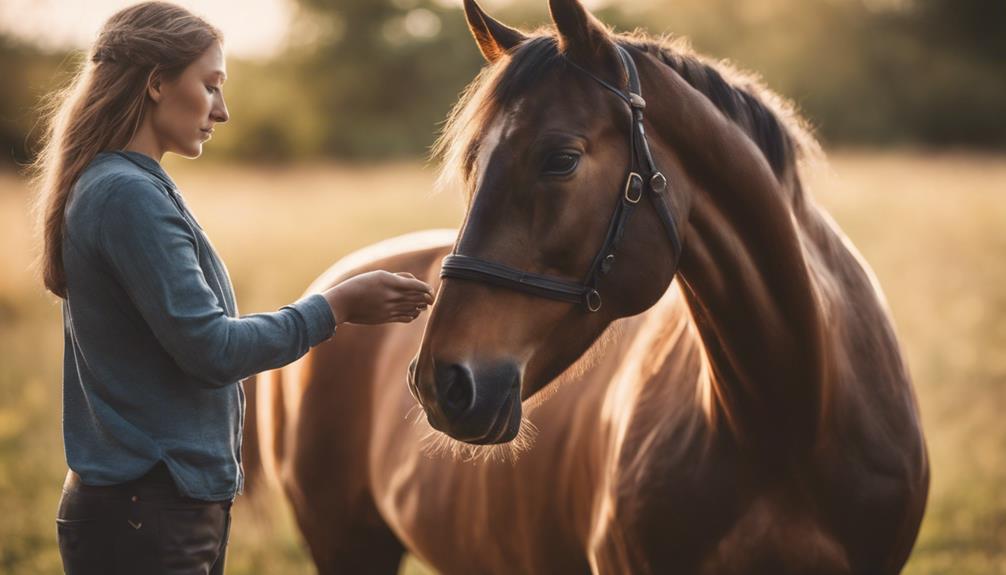Why Are These Horse Training Techniques Top-Rated?
When it comes to horse training techniques, Positive Reinforcement Training has been gaining significant attention. Have you ever wondered what sets these methods apart and why they are so highly regarded in the equine world?
By exploring the benefits of Clicker Training, the importance of Groundwork for Racehorses, and the significance of Mental Training Techniques, you will uncover the secrets behind why these techniques are considered top-rated in the industry.
Positive Reinforcement Training
When training your horse, using positive reinforcement techniques can significantly enhance the learning experience. Operant conditioning, which involves the use of rewards and punishments to shape behavior, is a fundamental principle in animal psychology. By understanding these concepts and applying them effectively, you can establish clear communication with your horse and foster a positive training environment.
In operant conditioning, behaviors are modified through the use of consequences such as rewards or punishments. By rewarding desired behaviors, such as responding to cues or performing tasks correctly, you can reinforce these actions and increase the likelihood of them being repeated. This process, known as behavioral shaping, is a powerful tool in horse training as it allows you to gradually shape complex behaviors through a series of small steps.
Clicker Training Benefits
Clicker training offers numerous benefits for enhancing your horse's learning and behavior. By utilizing a clicker paired with rewards like treats, you can effectively communicate with your horse and reinforce desired actions. One of the key advantages of clicker training is the cognitive benefits it provides to your horse. The process of associating the sound of the clicker with a reward stimulates your horse's brain and enhances its ability to learn new tasks quickly. This can lead to improved problem-solving skills and overall mental agility.
Moreover, clicker training is highly effective for behavior modification in horses. The precise timing of the clicker allows you to pinpoint the exact moment when your horse exhibits the desired behavior, making it easier for them to understand what you're asking for. This clear communication helps in shaping your horse's behavior positively and can be particularly useful in addressing unwanted behaviors or teaching complex tricks.
Groundwork for Racehorses
Groundwork is essential for preparing racehorses for optimal performance on the track. It lays the foundation for a strong relationship between you and your horse while improving their physical and mental capabilities.
Balance exercises play a crucial role in developing the horse's coordination and stability. By incorporating activities like walking over poles or navigating obstacles, you help the horse become more agile and sure-footed during races.
Desensitization techniques are another key aspect of groundwork for racehorses. These methods involve exposing the horse to various stimuli, such as loud noises, waving flags, or fluttering tarps, to reduce their sensitivity and fear responses. Through systematic desensitization, your horse can learn to remain calm and focused even in high-pressure race environments.
When practicing groundwork with your racehorse, remember to be patient and consistent. Building trust and communication through these exercises won't only enhance your horse's performance but also strengthen your bond.
Interval Training Importance
To enhance your racehorse's performance and endurance, incorporating interval training is crucial. Interval training involves alternating between high-intensity bursts of speed and periods of active recovery. This type of training is highly effective in building endurance and improving speed. By pushing your horse to work at near-maximum effort during the high-intensity intervals, you stimulate physiological adaptations that lead to enhanced performance on race day.
One key benefit of interval training is its ability to improve both aerobic and anaerobic capacity. The intense intervals push your horse's cardiovascular system to work harder, increasing its overall endurance. Simultaneously, the active recovery periods allow for partial replenishment of energy stores, enabling your horse to sustain high speeds for longer durations. This balance between pushing limits and allowing recovery is essential for optimal performance.
In addition to endurance building and speed improvement, interval training also plays a crucial role in enhancing overall performance. By challenging your horse with varied intensities, you stimulate muscle growth and efficiency. Furthermore, incorporating proper recovery strategies, such as adequate rest and nutrition, after interval training sessions is essential for maximizing its benefits. This holistic approach ensures that your racehorse remains healthy, strong, and primed for success on the track.
Proper Nutrition for Athletes
Proper nutrition plays a vital role in optimizing the performance and well-being of athlete horses. Hydration strategies are crucial for maintaining peak performance levels during training and competitions. Make sure your horse has access to clean water at all times and consider electrolyte supplementation, especially in hot weather or during intense workouts.
When it comes to meals, focus on providing balanced pre-workout meals that include a good mix of carbohydrates, proteins, and fats. This will give your horse the energy it needs to perform at its best. After a workout, offer post-workout snacks rich in proteins and carbohydrates to support muscle recovery and replenish glycogen stores.
Recovery methods are just as important as training itself. Ensure your horse has enough time to rest and recover between workouts. Implementing proper cooling down techniques and massages can help prevent injuries and keep your horse in top condition.
Benefits of Cross-Training
Implementing a diverse training regimen can enhance your horse's overall performance and well-being. Cross-training, which involves incorporating various exercises and activities into your horse's routine, offers several benefits.
Firstly, it helps with strength and conditioning. By engaging in different types of exercises such as hill work, pole work, and interval training, your horse can develop muscle strength and cardiovascular endurance more effectively than with repetitive training alone. This leads to improved stamina and performance in various equestrian disciplines.
Agility training is another key advantage of cross-training. Agility exercises like weaving through poles, navigating obstacles, and practicing quick direction changes can enhance your horse's flexibility, coordination, and responsiveness. These skills are crucial for activities such as jumping, dressage, and trail riding, where the horse needs to maneuver swiftly and accurately.
Moreover, cross-training helps prevent boredom and burnout in your horse. By introducing new activities and keeping the training sessions varied and stimulating, you can maintain your horse's interest and motivation, leading to a happier and more engaged equine partner.
Mental Training Techniques

Enhance your horse's mental acuity and focus through targeted mental training techniques. By incorporating focus exercises and visualization techniques into your training regimen, you can help your horse develop a sharper and more attentive mind.
Focus exercises such as pattern recognition tasks or obstacle courses can challenge your horse's concentration and improve their ability to stay on task during training sessions. Visualization techniques, where you mentally walk through a desired behavior or performance with your horse, can also enhance their focus by creating a clear picture of what's expected.
In addition to focus exercises and visualization techniques, incorporating relaxation techniques and stress management strategies into your training routine can further benefit your horse's mental well-being. Just like humans, horses can experience stress and anxiety, which can hinder their ability to learn and perform at their best.
Consistency in Training Regimen
Maintaining a consistent training regimen is crucial for optimizing your horse's performance and progress. By adhering to a routine that incorporates behavior modification and reinforcement techniques, you can effectively shape your horse's behaviors and responses. Consistency in training allows your horse to understand expectations and aids in reinforcing desired actions.
Training frequency plays a significant role in the effectiveness of your horse's progress. Regular sessions help solidify learning and prevent regression. It's essential to establish a balanced schedule that challenges your horse without overwhelming it. Tracking your horse's progress is equally important. By keeping detailed records of each training session, you can identify patterns, successes, and areas that require improvement. Progress tracking enables you to adjust your training regimen accordingly, ensuring continuous growth.
Consistency in training also fosters a strong bond between you and your horse. Through regular interactions and structured sessions, you build trust and communication, which are essential for a successful partnership. Consistent training instills confidence in your horse, leading to a more reliable and willing companion. Remember, consistency is key in achieving your training goals and maximizing your horse's potential.
Frequently Asked Questions
How Do Horse Training Techniques Impact the Overall Well-Being and Mental Health of the Horse?
When training impacts a horse's mental well-being, it influences their overall health. Proper techniques build trust and confidence, leading to a happy and well-adjusted horse.
On the flip side, negative training methods can cause stress, fear, and behavioral issues. It's crucial to prioritize positive reinforcement, patience, and understanding in your training approach to ensure the best mental health for your equine companion.
Are There Any Potential Risks or Drawbacks Associated With Using Positive Reinforcement and Clicker Training in Horse Training?
When using positive reinforcement and clicker training in horse training, there are potential risks and drawbacks to consider. These may include inadvertently reinforcing unwanted behaviors, over-reliance on treats, and the need for consistent timing and clarity in communication.
Despite these challenges, the effectiveness of these techniques in enhancing learning, building trust, and promoting a positive relationship with the horse shouldn't be overlooked. Ethical considerations also play a crucial role in implementing these methods responsibly.
How Can Trainers Determine the Appropriate Level of Intensity for Interval Training in Racehorses?
When determining intensity for interval training in racehorses, start by assessing the horse's fitness level. Gradually increase the intensity as the horse improves.
Monitor performance and adjust the training accordingly. Keep training duration appropriate to prevent overexertion and injury. Balancing intensity and duration is key to optimizing racehorse training.
What Role Does Genetics Play in Determining a Horse's Response to Specific Training Techniques?
Genetic predisposition plays a key role in how your horse responds to different training methods. It can influence their behavioral responses and ultimately impact training outcomes.
How Can Trainers Ensure That Their Horses Receive Adequate Rest and Recovery Time Between Training Sessions to Prevent Burnout and Injuries?
To ensure your horses stay healthy and injury-free, focus on proper rest management. Allow for adequate recovery time between training sessions. By giving your horses time to rest, you prevent burnout and reduce the risk of injuries.
Pay attention to their fatigue levels and adjust their training schedule accordingly. Prioritize their well-being with sufficient rest periods, promoting longevity and peak performance in your equine companions.
Conclusion
You now understand why these horse training techniques are considered top-rated. By incorporating:
- Positive reinforcement
- Clicker training
- Groundwork
- Interval training
- Proper nutrition
- Cross-training
- Mental techniques
- Consistency
into your regimen, you're setting your horse up for success.
Remember, a well-rounded approach to training is key in developing a strong, healthy, and happy athlete.
Keep up the good work and watch your horse thrive!
